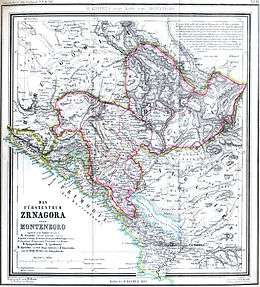Old Montenegro
Old Montenegro (Serbian and Montenegrin: Стара Црна Гора / Stara Crna Gora),[1][2][3] also known as Montenegro proper (Serbian: Права Црна Гора; Montenegrin: Prava Crna Gora),[4][5] or True Montenegro (Serbian: Истинска Црна Гора; Montenegrin: Istinska Crna Gora),[6][7] is a term used for the embryonic part of modern Montenegro. In historical context, the term designates the original territory of the Principality of Montenegro, before the territorial expansion, ratified by the Congress of Berlin in 1878, or even more precisely - the territory of the Prince-Bishopric of Montenegro prior to its unification with the region of Brda in the first half of the 19th century.[8][4]

During the Ottoman period, from the 16th up to the 18th century, the original (proper) Montenegro was made up of the Montenegrin tribes (Serbian: црногорска племена; Montenegrin: crnogorska plemena), traditionally divided into four territorial units, or nahije: Katun, Rijeka, Lješanska nahija and Crmnica. Their inhabitants were known under the regional demonym Montenegrins (Serbian: Црногорци; Montenegrin: Crnogorci), as opposed to the inhabitants of neighboring regions (Brđani, Hercegovci and Primorci). Since the end of the 18th century, Montenegro started to expand, incorporating the region of Brda in the first half of the 19th century, the region of Old Herzegovina and part of Primorje in 1878, and finally upper and central Polimlje and northern Metohija in 1912.[9]
Tribes

.png)
Tribes, divided by nahija.
|
See also

- History of Montenegro
- Sanjak of Montenegro
- Vilayet of Montenegro
- Prince-Bishopric of Montenegro
- Brda (Montenegro)
- Old Herzegovina
- Primorje (Montenegro)
- Serbs of Montenegro
References
- Ердељановић 1926.
- Радусиновић 1985a.
- Радусиновић 1985b.
- Banac 1992, p. 271.
- Fleming 2002, p. 56.
- Brown 1954, p. 101.
- Bećković 2005, p. 53.
- Denton 1877, p. 52.
- Ćirković 2004.
Sources
- Banac, Ivo (1992) [1984]. The National Question in Yugoslavia: Origins, History, Politics (2. printing of the 2. ed.). Ithaca, N.Y: Cornell University Press.CS1 maint: ref=harv (link)
- Bataković, Dušan T., ed. (2005). Histoire du peuple serbe [History of the Serbian People] (in French). Lausanne: L’Age d’Homme.CS1 maint: ref=harv (link)
- Bećković, Matija (2005). A Stone Between Two Worlds. Toronto: Serbian Literary Company.CS1 maint: ref=harv (link)
- Brown, Alec (1954). Yugoslav Life and Landscape. London: Elek Books.CS1 maint: ref=harv (link)
- Ćirković, Sima (2004). The Serbs. Malden: Blackwell Publishing.CS1 maint: ref=harv (link)
- Denton, William (1877). Montenegro, its people and their history. London: Daldy, Isbister & Company.CS1 maint: ref=harv (link)
- Ердељановић, Јован (1926). Стара Црна Гора: Етничка прошлост и формирање црногорских племена. Српски етнографски зборник. 39. Београд: Српска краљевска академија.CS1 maint: ref=harv (link)
- Fine, John Van Antwerp Jr. (1994) [1987]. The Late Medieval Balkans: A Critical Survey from the Late Twelfth Century to the Ottoman Conquest. Ann Arbor, Michigan: University of Michigan Press.CS1 maint: ref=harv (link)
- Fleming, Thomas (2002). Montenegro: The Divided Land. Rockford, Illinois: Chronicles Press.CS1 maint: ref=harv (link)
- Jelavich, Barbara (1983a). History of the Balkans: Eighteenth and Nineteenth Centuries. 1. Cambridge University Press.CS1 maint: ref=harv (link)
- Jelavich, Barbara (1983b). History of the Balkans: Twentieth Century. 2. Cambridge University Press.CS1 maint: ref=harv (link)
- Радусиновић, Павле С. (1985a). Насеља Старе Црне Горе: Општи дио. 1. Београд: Српска академија наука и уметности.CS1 maint: ref=harv (link)
- Радусиновић, Павле С. (1985b). Насеља Старе Црне Горе: Посебни дио. 2. Београд: Српска академија наука и уметности.CS1 maint: ref=harv (link)
- Stefanović-Karadžić, Vuk (1837). Montenegro und die Montenegriner: Ein Beitrag zur Kenntniss der europäischen Türkei und des serbischen Volkes. Stuttgart und Tübingen: Verlag der J. G. Cotta'schen Buchhandlung.CS1 maint: ref=harv (link)
- L'examen des dialectes du Vieux Monténegro (Stara Crna Gora) en tenant compte des parles voisins, Bulletin international de l' Académie polonaise des sciences et des letters N 1—3 (janvier-mars), 1—13, Cracovie 1932.
